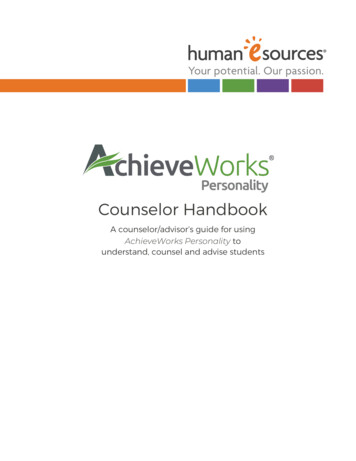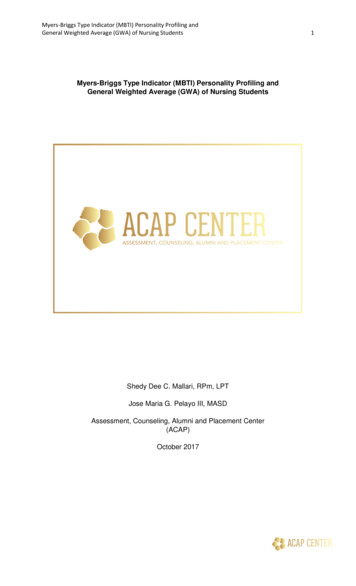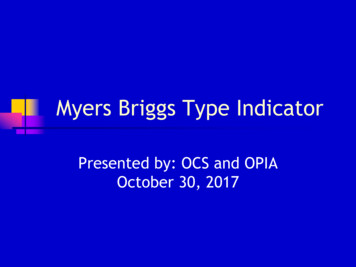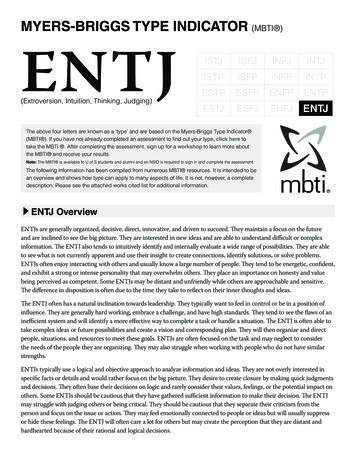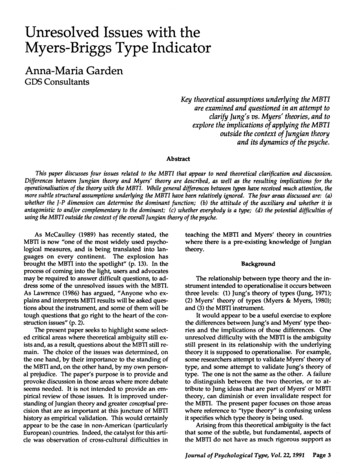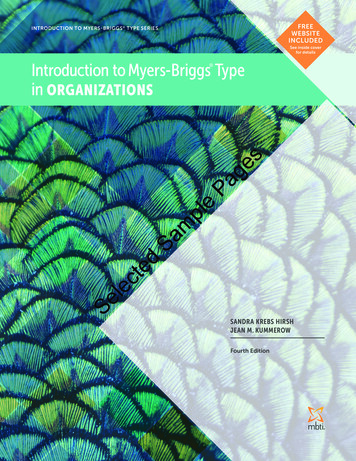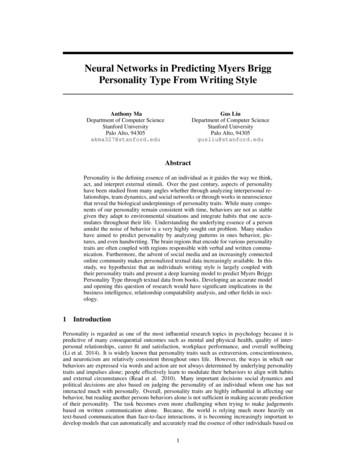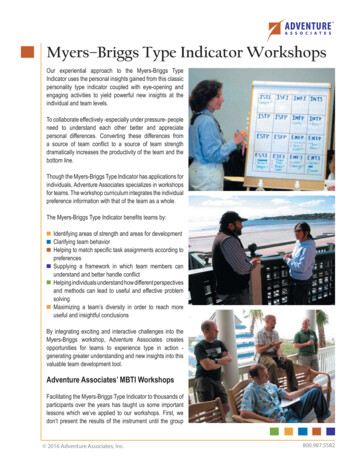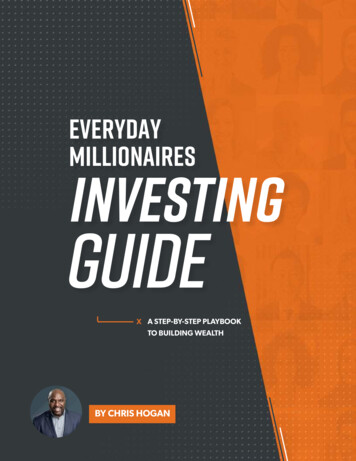
Transcription
THE EVERYDAY MILLIONAIRE’S // INVESTING PLAYBOOKEVERYDAYMILLIONAIRESINVESTINGX A STEP-BY-STEP PLAYBOOKTO BUILDING WEALTHXCHRISHOGANHOGANBYBYCHRISA STEP-BY-STEP GUIDE TO BUILDING WEALTH
Table of contentsWhy You Need to Invest 15% of Your Income . . Page 8Diversification: Eggs in Different Baskets . . Page 11Start Here: Steps for Investing in Your 401(k) . Page 15What to Do With an Old 401(k) or Employer Plan . Page 19Investing in Both a 401(k) and a Roth IRA . . Page 19Your Investments Hard at Work: Compound Interest . Page 21Benefits of Working With a Financial Advisor . . Page 23chrishogan360.comUnderstanding Fees . . Page 27Congratulations! If you’re reading this guide, you’re ready to dig in and build wealth theright way for your future. This is the first time all of my investing advice is found in one place,without having to attend and travel to one of my events. I can’t wait to guide you step-by-stepwith this information so you can feel confident about investing and saving for the future.INVESTING GUIDE // 1
Before You StartInvesting, Workthe Baby StepsAny successful investment strategy relies on a firm financial foundation, so it’s importantto lay the groundwork by working through the Baby Steps. In other words, I want you toget out of debt and have a full emergency fund before you start investing.Your income is your most powerful wealth-building tool. But as long as it’s tied up indebt payments, you can’t build wealth. And if you begin investing before you’ve built upyour emergency fund, you could end up tapping into your retirement accounts when anemergency comes along.So, if you haven’t paid off all your debt (except your home) and saved three to six monthsof expenses in an emergency fund, then postpone investing for now. However, onceyou’ve reached that point, you’re ready to get serious about investing for the future. Andthat’s exciting!
“SUCCESS IS THE RESULTOF FOLLOWING THROUGHON SMALL COMMITMENTSEVERY DAY.
THE BIGPICTURE OFINVESTINGINVEST15%GROSS INCOMEOnce you get out of debt, you need to start investing 15% of your gross income intomutual funds for retirement. This will allow you to save for the future while also takingcare of other financial needs like paying for kids’ college and paying off your mortgage asquickly as possible. Here’s an overview of what that investing should look like:1 INVEST IN A 401(k) OR ROTH 401(k).A 401(k) is an employer-sponsored savings program that allows you to contributepart of your income into a retirement savings account. Your money is then putinto different mutual funds of your choosing. I suggest contributing up to theemployer’s match.However, some companies now offer Roth 401(k) plans. With a Roth 401(k), yourcontributions are made with after-tax dollars. That means you won’t pay taxeswhen you take out money in retirement. If your Roth 401(k) offers good mutual fundoptions, you can invest your entire 15% there and skip Steps 2 and 3 on the next page.INVESTING GUIDE // 4
2 CONTRIBUTE TO A ROTH IRA UP TO THE ANNUAL MAX.A Roth IRA (Individual Retirement Arrangement) is similar to a Roth 401(k) becausetaxes are taken out before you invest your money. But a Roth IRA isn’t offered byyour employer—you go through a bank or investing firm. As of 2019, a Roth IRA hasan annual contribution limit of 6,000 ( 7,000 if you’re 50 or older).Once you’ve reached the match in your company’s 401(k) plan, invest in a RothIRA up to the contribution limit.If your company doesn’t have a company match, max out your Roth IRA first soyou get the tax benefit when you retire. Then you can invest in a 401(k).3 INVEST THE REST OF YOUR 15%.If you’ve invested in your 401(k) and a Roth IRA and still haven’t reached 15% of yourgross income, keep bumping up your contribution to your 401(k) until you hit 15%.For example, if your company will match 4% of your 401(k) contributions, invest 4%in that account and then put the remaining 11% in a Roth IRA. If that remaining 11%doesn’t put you at the annual contribution limit for a Roth IRA ( 6,000–7,000), maxout that Roth IRA and then go back to your 401(k) to finish out investing 15%. Thecompany match does NOT count as a part of the 15%. 75,000 11,25015% of 75,000 yearly salary InvestedINVESTING GUIDE // 5
“ROTH 401(k)CONTRIBUTIONS ARE MADEWITH AFTER-TAX DOLLARS.
“ MOST PEOPLEDON’T PUT AWAYNEARLY ENOUGH.
WHY YOU NEEDTO INVEST 15%OF YOUR INCOMEOne of the most common questions about investing is how much you should invest. Most peopledon’t put away nearly enough. You need to invest 15% of your gross income. Here’s why:Because You Want a Bigger Nest EggThe U.S. Census Bureau says the median household income is around 59,000.(1)Fifteen percent of that would be 8,850 a year, or 737.50 a month. Over 30 years, thatcould grow to 1.6 million, assuming a 10% return. Sounds awesome, right? Who doesn’twant to be a millionaire?But look at what happens if you drop that 15% down to 5.5%—the average personalsavings rate in the U.S.(2) At that percentage, you’re investing 3,245 a year, or around 270 a month. Over 30 years, assuming that same 10% rate of return, you could be looking at 586,256. Acting like everybody else could get you about 586,000 for retirement. But choosing tobe smarter and investing 15% could mean 1.6 million. Which do you want?
““CHOOSING TO BE SMARTERAND INVESTING 15% COULDMEAN 1.6 MILLION.chrishogan360.com
Because Social Security Won’t Replace Your IncomeI’ve heard a lot of people say that they’re counting on Social Security to payfor expenses during retirement. That’s a bad financial plan. In 2017, theaverage monthly benefit for retired workers was 1,369 a month.(3) That’sonly 16,428 a year. To give you some perspective, the federal poverty levelfor a family of two (that’s you and your spouse if you’re married) is currently 16,240.(4) Do you want to live just above the poverty level? Me neither.Social Security is icing on the cake. It’s a nice addition, but it’s not the heart ofyour retirement plan.Because Medical Care Is Expensive in RetirementFidelity estimates that a 65-year-old couple will need 275,000 for health carecosts in retirement.(5) That doesn’t include any long-term care costs, whichcould reach around 138,000 per person!(6) Even if you’re healthy now, theAdministration on Aging estimates that people turning 65 today have almosta 70% chance of needing some kind of long-term care in their remainingyears.(7) You do not want to mess with those odds! You need a solid retirementnest egg.The Average 65-year-old couple willneed 275,000 for health carecosts in retirement.
DIVERSIFICATION:PUTTING YOUR EGGSIN DIFFERENT BASKETSThe word “diversification” is one of those 20 words you hear in financial news. Here’s asimple definition: To spread out your money across different kinds of investments.Think of the old proverb, “Don’t put all your eggs in one basket.” In this situation, the eggsrepresent your money and the basket represents mutual funds.The easiest way to make sure your investment portfolio is diversified is by putting yourmoney into four different mutual funds. Here are the funds you’re looking for:Growth and Income (25%): These funds bundle stocks from larger, moreestablished companies. These funds are the most predictable and are less prone towild highs or lows. Typically, though, they won’t earn as much money as other funds.Growth (25%): These funds are made up of stocks from growing companies. Theyoften earn more money than growth and income funds but less than aggressivegrowth funds.Aggressive Growth (25%): These funds have the highest risk and highest possiblereward. They’re made up of stocks in companies that have high growth potential, butthey’re also less established and could swing widely in value.International (25%): These funds are made up of stocks from companies outside the U.S.
25%GROWTH LPut your money into fourdifferent mutual fundsTo diversify your portfolio, you need to put your money equally across these fourkinds of funds. That way if one type of fund (like international) isn’t doing well, otherfunds can balance it out. And, by investing in multiple mutual funds, you ensure thatthey all smooth each other out, too. You don’t have that safety net if you invest insingle stocks, which is why I never recommend doing that. You never know whichstocks will go up and which will go down, so diversifying your investments gives youthe best protection against huge losses.INVESTING GUIDE // 12
ONE DAYYOU’LL THANKYOURSELFFOR NEVERGIVING UP.chrishogan360.com
When Do You Dropa Mutual Fund?If a fund doesn’t perform well over the long haul or if it’s not a good fit for youroverall strategy, it may be time to drop that fund from your portfolio. Here aresome things to look at when deciding whether to drop a mutual fund. As always,talk with your financial advisor before you make that decision.Expense Ratio Too High: Though you should never choose a mutual fund based onits expense ratio alone, understanding a fund’s expenses is important. The money youpay toward expenses and fees is money that’s not in your portfolio earning you interest.Too Much Turnover: When a fund has a high turnover rate (how often the fund’sholdings are bought and sold each year), it can lead to significant fees for you andpotential tax implications. A lower turnover ratio also shows that the managementteam isn’t trying to time the market for a bigger return.Out of Balance: Over time, the market fluctuates and shares are bought and sold, soyour portfolio will change. This may mean you no longer have 25% of your investmentin each of the four categories. To get back on track, your investment professional canrebalance your funds, or they may recommend dropping a fund in favor of a different one.Listen up, because this is important: I don’t ever want you to drop a fund becauseyou’re nervous about the market. If you’re anxious, talk with your investing pro. They’llbe able to guide you through the ups and downs of investing.INVESTING GUIDE // 14
STEPS FORiNVESTING INYOUR 401(k)With all the jargon and terms and paperwork, some people can get confused abouthow to invest in their 401(k), 403(b) or 457. Don’t worry—it’s easier than you think.Here are the basic steps for getting started with your workplace investing. In the stepsbelow, I use the term 401(k), but the process is very similar for 403(b) and 457 plans.Keep that in mind.1 START WITH YOUR PLAN DOCUMENT.The best place to start making your selections is your company’s PlanDocument. It gives you all the important details about your company’sretirement plan. It also includes information about the fees related to your401(k), the services available to you and how to make changes.2 COMPLETE YOUR PLAN ENROLLMENT FORM.This is what you’ve been waiting for! You’ll use the enrollment form todesignate a percentage of your paycheck for retirement. But there are acouple of other things about this form you need to pay attention to:chrishogan360.comPRE-TAX OR ROTH: If your company offers both options, you’ll needto decide between a traditional 401(k) and a Roth 401(k). Remember, atraditional 401(k) allows you to make contributions from your pay beforetaxes are taken out. In a Roth 401(k), your contributions are made aftertaxes are taken out. I recommend investing in a Roth option because themoney grows tax-free and you’re not taxed on any withdrawals in retirement.
AUTOMATIC REBALANCING: If it’s available, it’s a good idea to select theautomatic rebalancing option for your 401(k) selections. Once a year, your fundmanager will rebalance your funds to protect your nest egg from stock marketups and downs. That’s because over time, one fund will perform better and a goodportion of your portfolio could be from that fund. For example, your aggressivegrowth funds may outperform expectations, while your growth and income fundsmove at a snail’s pace. When the market turns, however, your aggressive growthfunds may take a hit, while your growth and income funds keep their slow andsteady pace. That’s why automatic rebalancing is important.3 LEARN ABOUT YOUR INVESTMENT OPTIONS.Remember that brochure or booklet that came with your 401(k) enrollment packetfrom HR? It should provide descriptions of all your 401(k) selection options.However, no brochure is going to give you the complete lowdown on all yourinvesting choices. And those brochures will suggest investing in target date funds,which contain predetermined investment mixes depending on the date you plan to retire.I don’t like target date funds for two reasons. First, you will have the tendency to goon autopilot and forget about your investments. And that’s not okay! I want you toknow what you’re investing in and why. Second, your retirement could last decades,so you don’t want your investments to stop growing! If you end up not using all yourmoney, you get to leave an amazing legacy for your kids and grandkids.
4 Pick the Right Funds for Your 401(k).Your company’s 401(k) provider will ask which mutual funds you want to invest inand in what percentages. Since choosing the right mutual funds can go a long waytoward helping you reach your financial goals and prevent unnecessary risk, you wantto compare your options before making your selections. Here are a few questions toconsider as you decide which funds are best for you: Does this fund cover different business sectors like financial services,technology and health care? Has the fund outperformed other funds in its category over the past 10years or more? What costs are associated with the fund? How often are investments bought and sold within the fund?If you can’t find answers to these questions on your own, ask your financial advisor for help.It’s worth the extra time to know you’re making an informed decision about your investments.Investing pros may charge a one-time fee for a 401(k) consultation, and that’s areasonable cost for the time they spend to help you make smart 401(k) selections.Just make sure you know what to expect before your appointment so there are nosurprises.5 DON’T OVERLOOK YOUR BENEFICIARY DESIGNATION FORM.Anyone who’s filled out a life insurance application is familiar with a beneficiary form.chrishogan360.comThis is where you state who will receive the money from your 401(k) in the event ofyour death. If you’re married and have kids, this probably won’t be a tough decision.This is one form people fill out and forget. If you divorce or remarry, have children, orlose a spouse, make sure you update this form.INVESTING GUIDE // 17
CONSISTENCY &PERSISTENCECREATE RESULTS.
WHAT TO DOWITH AN OLD401(k)If you have an old 401(k) or a similar account—such as a 403(b) or 457—from a previousemployer, you have three options:1Leave your 401(k) at your old job (not always possible or a good idea).2Transfer the money into your new employer’s plan (not always possible).3Roll over the funds into an IRA (usually the best option).Cashing out your 401(k) is an option, but mark it off the list. You’d lose about 40% ofyour money in taxes, fees and penalties. Options No. 1 and 2 may not be available toyou, nor are they particularly good options. The best option, No. 3, is to roll over thefunds directly from your 401(k) into an IRA. And that’s easy to do.How to Roll Over A401(k) into an IRAThe important part of putting your 401(k), 403(b) or 457 funds into an IRA is the paperwork.The process itself is not complicated, but it takes a few steps:1 Call the 401(k) Administrator.Ask them for the forms you’ll need to complete to make the transfer. If you’renot sure who to call, talk to someone in the HR department.INVESTING GUIDE // 19
2 Open an IRA.If you work with an investing pro, ask them for help. You can also open an IRAthrough a bank, mutual fund company or brokerage firm. You’ll need your SocialSecurity number and driver’s license or another ID. That account will be empty fornow. That’s what happens in Step 3.3 Request and Confirm a Direct Electronic Transfer. The money shouldgo directly from the old 401(k) account to the IRA account. Don’t ever have fundsgiven to you. You’ll pay big bucks in taxes and penalties.4 Make Your Investment Choices. Your new IRA is like a sack that holds yourgroceries. You still have to choose the groceries—in this case, the mutual funds.Again, you can talk with your investing pro for help with this.As soon as possible, start contributing to your new employer’s 401(k) plan, and makesure you get the most out of any employer matching. If there is a waiting period beforeyou can opt in, or if the new company doesn’t offer a 401(k), then contribute to yourIRA every month, up to 6,000 a year. And make sure the money is automaticallywithdrawn from your paycheck.Can I Roll Over a401(k) into a Roth IRA?You can also roll over an old 401(k) into a Roth IRA. The process is the same as with anIRA. However, when you choose a Roth IRA, you’ll have to pay taxes on the money in yourtaxes for that year.Now, if you have the cash on hand to pay those taxes, a Roth IRA is probably a goodoption. The money then grows tax-free and you won’t pay taxes on the money when youtake it out at retirement. But never dip into the investment balance to pay the taxes on aRoth IRA conversion. You could be cheating yourself out of thousands of dollars that youcould have earned in compound interest.chrishogan360.com401(k) because it hasn’t been taxed yet. Those taxes will be due when you file your income
YOUR INVESTMENTSHARD AT WORK:COMPOUND INTERESTWhat’s one key to success in investing? Compound interest. Yep. It’s that basic. But you needto understand that compound interest works behind the scenes for years before you can seesignificant growth. But then out of nowhere, you’ll see crazy growth—if you’re patient.Let’s say you get a job at age 25 and take advantage of your company’s 401(k) plan. You’reyoung and your salary isn’t huge, but you put away 200 a month toward your investments.If you did that for 40 years, you’d contribute 96,000. But you’d earn over 1 million in growth,assuming a 10% return. If you’d put away 250 instead, you’d invest 120,000 over 40 years, but youcould end up with 1.3 million in growth. That’s how compound interest works.RULE OF 72: HOW LONG IT TAKES FOR INVESTMENTS TO DOUBLEYou might have heard the term, “Rule of 72.” It’s a simple math trick you can use to figureout compound interest. You simply divide the interest rate into 72. So, at an interest rate“of 10%, any money you have will take 7.2 years to double. In 7.2 years, 1,000 will become 2,000. It would take the same amount of time for 500,000 to become 1 million.Why is this information helpful? Because you can look at your current investmentportfolio and figure out how much time (roughly) it will take for that money to double. Italso shows the importance of giving compound interest plenty of time to do its work. Ifyou hang on, that 250 monthly investment could make you an everyday millionaire. Slowand steady wins the race.INVESTING GUIDE // 21
96,000 Original Investment40 Years and 10% Compound Interest 96,000 NOW EQUALS OVER 1 MILLION!LEAVE YOUR INVESTMENTS ALONE!Now, once you’ve opened an account and you’re putting away money everymonth, leave your investing portfolio alone, especially when the marketslumps. One moment of panic could cost you thousands of dollars or more!Historically in the investing world, what goes down eventually comes backup. For example, during the financial crisis of 2007–2009, the S&P 500 Index(which tracks the performance of the top 500 companies in the U.S.) dropped57% between October 2007 and March 2009.(8) However, the S&P bouncedback. By 2013, stock prices had recovered their losses and have been steadilyimproving since.(9)When you invest, you have to think long-term and wait patiently for yournest egg to grow. A good investing professional can help you through thosemarket highs and lows so you don’t make a dumb decision out of fear. Theycan also help you decide when or if it’s time to dump a fund.
“PROFESSIONALSPLAY TO WIN BECAUSETHAT’S HOW THEYGET PAID.BENEFITS OFWORKING WITH AFINANCIAL ADVISORSome people think they can manage their money on their own. Folks, that’s a really badidea. You want to work with a financial advisor, even if you’re young and just starting toinvest. Here’s why:1 Financial Advisors Keep Your Investment Plan on Track.Financial advisors can keep you on track in saving for retirement. In fact, a studyfrom John Hancock showed that 70% of those who work with a financial advisorare on track or ahead in saving for retirement, compared to just 33% of thosewho don’t use an advisor.(10) Seventy percent is a whole lot better than 33%!Here’s another stat that will motivate you: Fidelity surveyed its investors, and75% of them have more confidence in the investment accounts managed by afinancial advisor than accounts they manage themselves. In comparison, thosewho have a written plan prepared by a professional advisor have about 203,000saved for retirement.(11)
2 Financial Advisors Do More than Invest Your Money.Some people think that a financial advisor’s only job is to invest money. That’sone of their roles, but it’s not the only one. They can also work with you on awide range of other financial needs: REBALANCING INVESTMENTS: Remember, your investing portfoliois probably made up of different kinds of investments. As that portfoliogrows, you will need to rebalance the investments in it so that you have25% in each of the four fund types I suggested. A financial advisor canwork with you to make sure your funds stay balanced over time. SPENDING STRATEGIES: When you retire, which of your investmentswill require a minimum withdrawal every year? Which income streamshould you tap first? Questions like these are critical when you startusing the money you’ve been saving. A financial advisor can help youmake the best decisions in this area. TAX PLANNING: Do you know what tax laws apply to your financialsituation? Or which investment will be taxed the most? A financialadvisor will know the answers to those questions. They know which ofyour assets will have the most impact on your taxes, when those taxesare due, and how much will be owed. Advisors help you stay on goodterms with Uncle Sam! ESTATE PLANNING: Your financial advisor can work with an estateattorney to make sure your assets are distributed according to yourinstructions, instead of being controlled by some random probate court.3 Everybody Has Blind Spots.When you’re driving, there’s that one spot in your car that blocks your line ofsight. And that can cause accidents if you change lanes too quickly. You haveblind spots in managing your wealth, too. For some, it’s emotions. For others,it’s misinformation. And those blind spots can cause big mistakes in yourfinancial planning. That’s why you need a financial advisor to guide you.
A pro can give you a 360-degree bird’s-eye view of your financial situation becausethey’re on the outside looking in. They can spot weak areas you may be blind toand give you advice on how to fix them, and they can give you educated advice onmaking wise money moves.4 Financial Advisors Save You Time and Stress.Think about your typical workday. You’re crazy busy from the time you wake up untilyou hit the pillow at night, aren’t you? Let me ask you an honest question: Do youreally think you can put in the hours of research it takes to choose the right mutualfunds and find the right balance of those funds?Fidelity surveyed its program participants, and they said that lack of time was onereason they started working with a financial advisor.(12) Even if I had the time, I’d muchrather spend it with my family. An afternoon tossing around the football with my boysis better than pouring over numbers. An advisor can save you countless hours thatyou just can’t get back otherwise.5 Financial Advisors Keep Your Emotions in Check.Listen to me, people: When the stock market takes a huge drop—like it did with thefinancial crisis of 2008—your stomach will start churning. You want to work with afinancial advisor who can remind you that the market has always gone back up, andyou don’t want to miss those future gains by cashing out. Otherwise, your emotionscould take over your logic and cause you to make some stupid decisions—like takingout all your money and hiding it under a mattress.That’s why you need an advisor. Feelings are real, but they don’t always tell you the truth.chrishogan360.comINVESTING GUIDE // 25
UNDERSTANDINGFEESNo matter where you work, there are costs for doing business. Some costs are related to peoplewho perform a service, like a teacher or a writer or an architect. Other costs are related to keepingthe business running, like computers and electricity and insurance.Investing is no different. There are costs associated with it. Some are people-related. Some areprocess-related. Here’s a quick breakdown of both:Understanding Investor FeesMost investing professionals are paid one of two ways: A fee-based pro receives ongoing pay based on a percentage of the assets theymanage for you. Their pay rises and falls based on how your portfolio is doing. A commission-based investing professional is paid up-front based on a percentageof the money you invest. That percentage varies from one investment to another.Each arrangement has its pros and cons, so you’ll need to decide which you prefer. Youcan find trustworthy, client-focused professionals who use either method. However, ifyour financial pro doesn’t take the time to explain the costs of their services or the feesassociated with your investments, that’s a huge red flag. If your pro gets defensive orangry when you ask questions, find somebody else to work with.
Understanding Mutual Fund FeesFees usually fall under two major umbrellas: transaction fees and ongoing fees.TRANSACTION FEES: Unlike ongoing fees, transaction fees are one-time expensesyou pay anytime someone makes a change to your investments (buys or sells mutualfund shares). These costs are also called shareholder fees or individual expenses. Hereare some common charges: Commissions (or sales charges) Redemption fees (when you sell shares in a fund) Exchange fees (taking money out of one mutual fund and putting it in another) Account service fees (if your account drops below a certain amount)The more you buy, sell, or change anything in your retirement account, the more feesyou pay. And that cuts into your retirement fund.ONGOING FEES: These are sometimes called annual operating expenses. Withthousands of different funds in the mutual fund industry worldwide, these feeamounts can differ a lot, but they usually pay for services like: Managing the fund’s portfolio (keeping track of what you’re invested in) Record keeping (tracking what you’ve bought or sold; sending information for filing taxes) Marketing fees (also known as 12b-1 fees) Customer service (telephone and web)chrishogan360.comINVESTING GUIDE // 27
Mutual funds bundle their ongoing fees into one category called an expense ratio. In 2017,the average expense ratio for equity mutual funds was .59 percent.(13) That means for every 1,000 worth of equity mutual funds you own, you’ll pay 59 in ongoing fees for that year. Asyour account grows (or drops) in value, so does the expense ratio. An expense ratio higherthan 1% is considered expensive.Some fees aren’t included in expense ratios, so watch out for those on your reports. Ifsomething looks fishy, ask about it. Don’t pay for something you don’t understand or don’tthink you owe. Also, watch out for companies that charge fees quarterly. You may be paying ahigher-than-average fee when added up for the year.An Example of Mutual Fund FeesLet’s say you’re 30 years old when you start investing, you have 10,000 to open your account,and you add 10,000 every year. Look at the balances when two different expense ratios areused for 40 years:Starting balance: 10,000Starting balance: 10,000 10,000 added annually 10,000 added annually– 1.25% expense ratio for 40 years– 0.25% expense ratio for 40 years 1.2 million 1.5 millionThat’s a difference of 350,000! I don’t know about you, but I’d rather have that extra moneyin my bank. And that’s with a return of 6%, which is less than the historical average of 1012%. That’s why you need to know how much you’re being charged in fees.
THFIND QUALIFIED INVESTINGPROFESSIONALS NEAR YOUFind Your Proschrishogan360.com
Now getto workI know this is a lot of information to remember. That’s okay. You can keep this guide and lookback at it from time to time to stay on track.If you’re ready to get to work, connect with a SmartVestor Pro. With this service, you will beconnected to investing professionals within minutes. Just enter your information and you’llget a list of several investing professionals in your area who know their stuff and want to help youbuild wealth.Remember, you control your financial future. You CAN build wealth following the steps inthis guide—and even become an Everyday Millionaire—if you’re willing to sacrifice, makesmart decisions and invest every month. I can’t wait to hear your story!find more tools and resources on How OrdinaryPeople Built Extraordinary wealth atchrishogan360.com
Your income is your most powerful wealth-building tool. But as long as it’s tied up in debt payments, you can’t build wealth. And if you begin investing before you’ve built up your emergency fund, you could end up

